Organisational Behaviour Report: Sainsbury - Motivation and Culture
VerifiedAdded on 2020/12/10
|14
|3210
|467
Report
AI Summary
This report provides an analysis of organizational behaviour within Sainsbury, a major UK supermarket chain. It begins by identifying Sainsbury's organizational culture using Handy's model, differentiating between power, task, person, and role cultures. The report then evaluates how communication models, such as the Shannon & Weaver and David Berlo models, improve the company's effectiveness by facilitating clear information transfer. Furthermore, it examines the role of culture in employee motivation, applying motivational theories like Herzberg's Two-Factor Theory, Maslow's Hierarchy of Needs, Vroom's Expectancy Theory, and Locke's Goal-Setting Theory to understand how to increase employee motivation. The report concludes by discussing how the strategic utilization of culture can enhance motivation, communication, and overall company success.
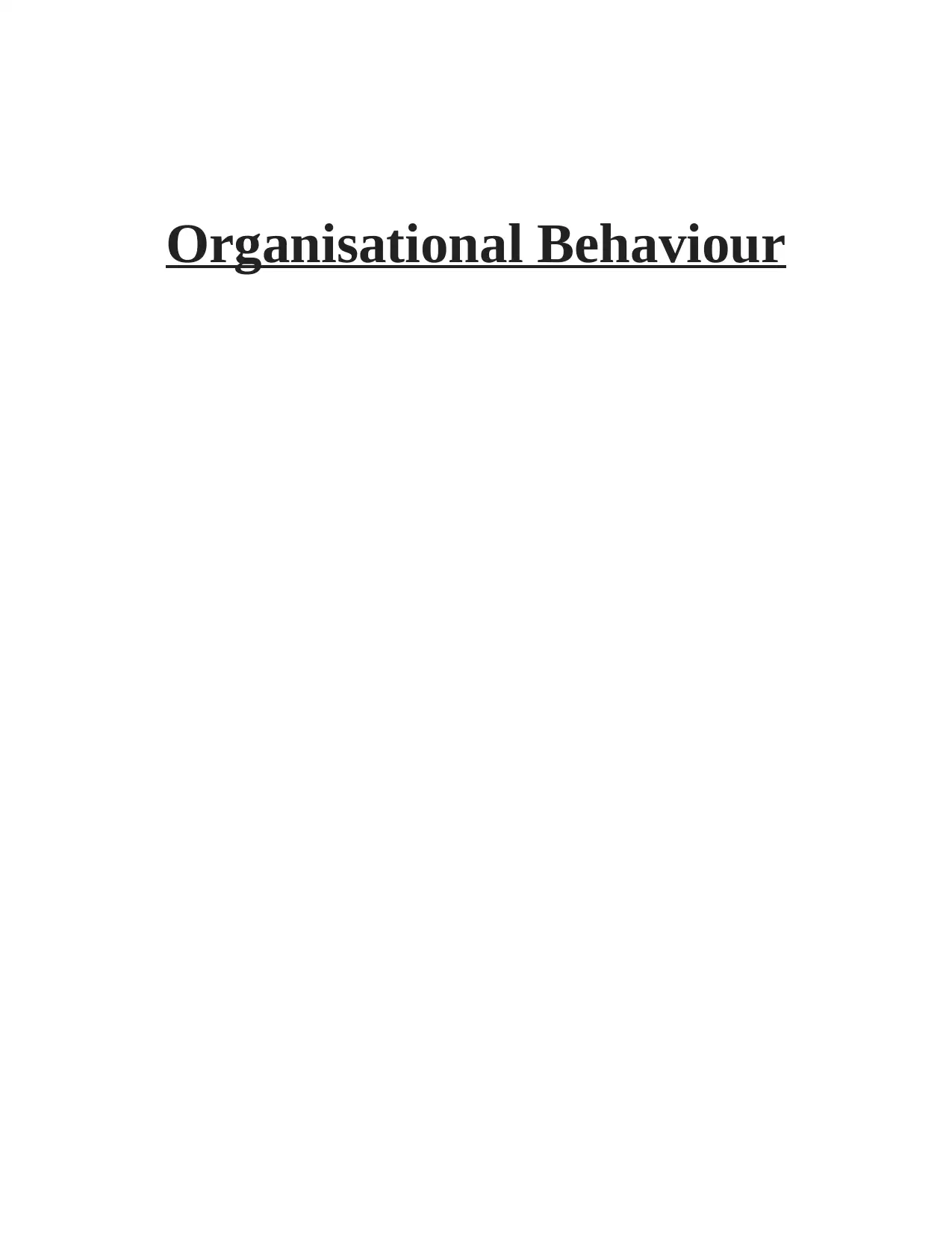
Organisational Behaviour
Paraphrase This Document
Need a fresh take? Get an instant paraphrase of this document with our AI Paraphraser
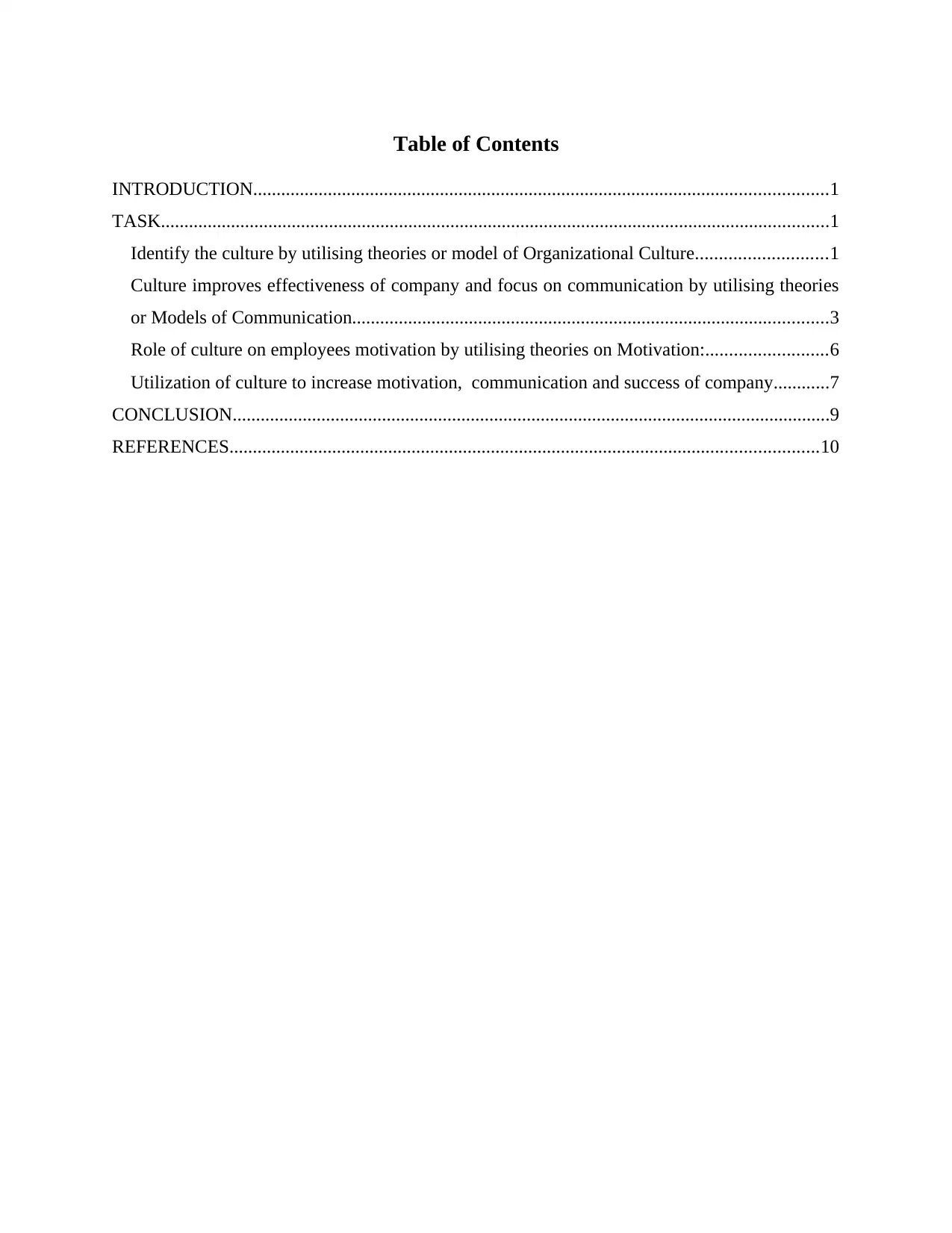
Table of Contents
INTRODUCTION...........................................................................................................................1
TASK...............................................................................................................................................1
Identify the culture by utilising theories or model of Organizational Culture............................1
Culture improves effectiveness of company and focus on communication by utilising theories
or Models of Communication......................................................................................................3
Role of culture on employees motivation by utilising theories on Motivation:..........................6
Utilization of culture to increase motivation, communication and success of company............7
CONCLUSION................................................................................................................................9
REFERENCES..............................................................................................................................10
INTRODUCTION...........................................................................................................................1
TASK...............................................................................................................................................1
Identify the culture by utilising theories or model of Organizational Culture............................1
Culture improves effectiveness of company and focus on communication by utilising theories
or Models of Communication......................................................................................................3
Role of culture on employees motivation by utilising theories on Motivation:..........................6
Utilization of culture to increase motivation, communication and success of company............7
CONCLUSION................................................................................................................................9
REFERENCES..............................................................................................................................10

⊘ This is a preview!⊘
Do you want full access?
Subscribe today to unlock all pages.

Trusted by 1+ million students worldwide
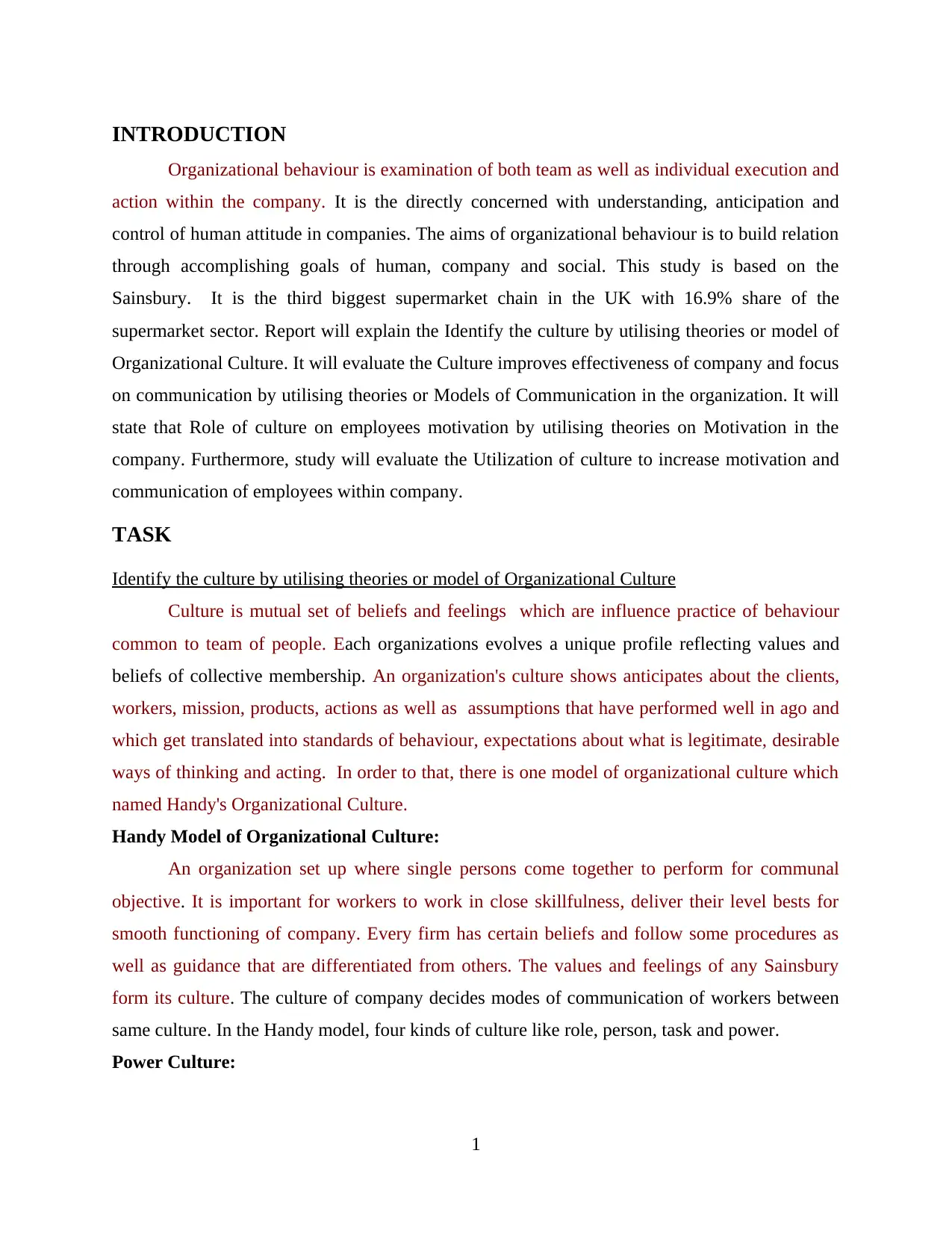
INTRODUCTION
Organizational behaviour is examination of both team as well as individual execution and
action within the company. It is the directly concerned with understanding, anticipation and
control of human attitude in companies. The aims of organizational behaviour is to build relation
through accomplishing goals of human, company and social. This study is based on the
Sainsbury. It is the third biggest supermarket chain in the UK with 16.9% share of the
supermarket sector. Report will explain the Identify the culture by utilising theories or model of
Organizational Culture. It will evaluate the Culture improves effectiveness of company and focus
on communication by utilising theories or Models of Communication in the organization. It will
state that Role of culture on employees motivation by utilising theories on Motivation in the
company. Furthermore, study will evaluate the Utilization of culture to increase motivation and
communication of employees within company.
TASK
Identify the culture by utilising theories or model of Organizational Culture
Culture is mutual set of beliefs and feelings which are influence practice of behaviour
common to team of people. Each organizations evolves a unique profile reflecting values and
beliefs of collective membership. An organization's culture shows anticipates about the clients,
workers, mission, products, actions as well as assumptions that have performed well in ago and
which get translated into standards of behaviour, expectations about what is legitimate, desirable
ways of thinking and acting. In order to that, there is one model of organizational culture which
named Handy's Organizational Culture.
Handy Model of Organizational Culture:
An organization set up where single persons come together to perform for communal
objective. It is important for workers to work in close skillfulness, deliver their level bests for
smooth functioning of company. Every firm has certain beliefs and follow some procedures as
well as guidance that are differentiated from others. The values and feelings of any Sainsbury
form its culture. The culture of company decides modes of communication of workers between
same culture. In the Handy model, four kinds of culture like role, person, task and power.
Power Culture:
1
Organizational behaviour is examination of both team as well as individual execution and
action within the company. It is the directly concerned with understanding, anticipation and
control of human attitude in companies. The aims of organizational behaviour is to build relation
through accomplishing goals of human, company and social. This study is based on the
Sainsbury. It is the third biggest supermarket chain in the UK with 16.9% share of the
supermarket sector. Report will explain the Identify the culture by utilising theories or model of
Organizational Culture. It will evaluate the Culture improves effectiveness of company and focus
on communication by utilising theories or Models of Communication in the organization. It will
state that Role of culture on employees motivation by utilising theories on Motivation in the
company. Furthermore, study will evaluate the Utilization of culture to increase motivation and
communication of employees within company.
TASK
Identify the culture by utilising theories or model of Organizational Culture
Culture is mutual set of beliefs and feelings which are influence practice of behaviour
common to team of people. Each organizations evolves a unique profile reflecting values and
beliefs of collective membership. An organization's culture shows anticipates about the clients,
workers, mission, products, actions as well as assumptions that have performed well in ago and
which get translated into standards of behaviour, expectations about what is legitimate, desirable
ways of thinking and acting. In order to that, there is one model of organizational culture which
named Handy's Organizational Culture.
Handy Model of Organizational Culture:
An organization set up where single persons come together to perform for communal
objective. It is important for workers to work in close skillfulness, deliver their level bests for
smooth functioning of company. Every firm has certain beliefs and follow some procedures as
well as guidance that are differentiated from others. The values and feelings of any Sainsbury
form its culture. The culture of company decides modes of communication of workers between
same culture. In the Handy model, four kinds of culture like role, person, task and power.
Power Culture:
1
Paraphrase This Document
Need a fresh take? Get an instant paraphrase of this document with our AI Paraphraser
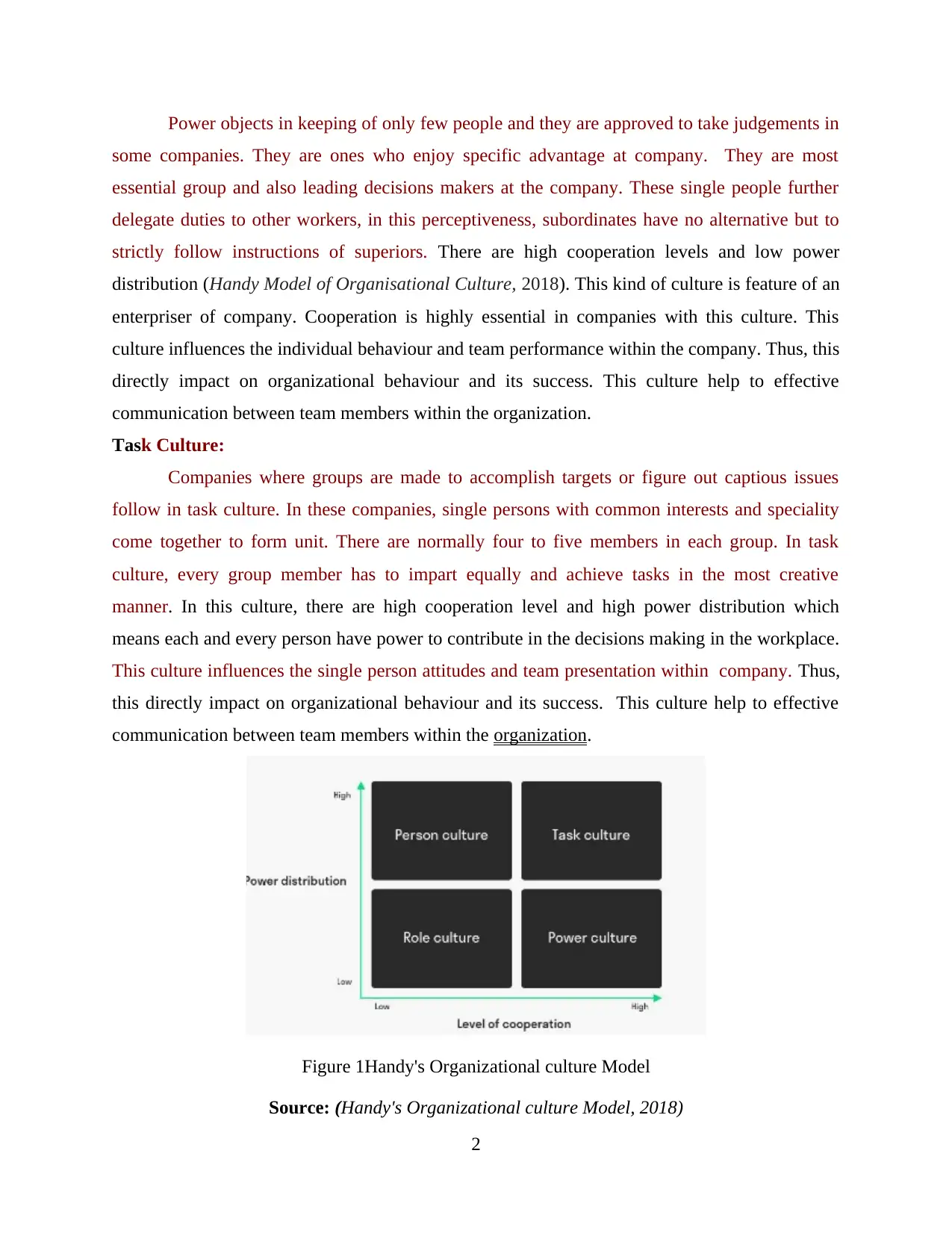
Power objects in keeping of only few people and they are approved to take judgements in
some companies. They are ones who enjoy specific advantage at company. They are most
essential group and also leading decisions makers at the company. These single people further
delegate duties to other workers, in this perceptiveness, subordinates have no alternative but to
strictly follow instructions of superiors. There are high cooperation levels and low power
distribution (Handy Model of Organisational Culture, 2018). This kind of culture is feature of an
enterpriser of company. Cooperation is highly essential in companies with this culture. This
culture influences the individual behaviour and team performance within the company. Thus, this
directly impact on organizational behaviour and its success. This culture help to effective
communication between team members within the organization.
Task Culture:
Companies where groups are made to accomplish targets or figure out captious issues
follow in task culture. In these companies, single persons with common interests and speciality
come together to form unit. There are normally four to five members in each group. In task
culture, every group member has to impart equally and achieve tasks in the most creative
manner. In this culture, there are high cooperation level and high power distribution which
means each and every person have power to contribute in the decisions making in the workplace.
This culture influences the single person attitudes and team presentation within company. Thus,
this directly impact on organizational behaviour and its success. This culture help to effective
communication between team members within the organization.
Figure 1Handy's Organizational culture Model
Source: (Handy's Organizational culture Model, 2018)
2
some companies. They are ones who enjoy specific advantage at company. They are most
essential group and also leading decisions makers at the company. These single people further
delegate duties to other workers, in this perceptiveness, subordinates have no alternative but to
strictly follow instructions of superiors. There are high cooperation levels and low power
distribution (Handy Model of Organisational Culture, 2018). This kind of culture is feature of an
enterpriser of company. Cooperation is highly essential in companies with this culture. This
culture influences the individual behaviour and team performance within the company. Thus, this
directly impact on organizational behaviour and its success. This culture help to effective
communication between team members within the organization.
Task Culture:
Companies where groups are made to accomplish targets or figure out captious issues
follow in task culture. In these companies, single persons with common interests and speciality
come together to form unit. There are normally four to five members in each group. In task
culture, every group member has to impart equally and achieve tasks in the most creative
manner. In this culture, there are high cooperation level and high power distribution which
means each and every person have power to contribute in the decisions making in the workplace.
This culture influences the single person attitudes and team presentation within company. Thus,
this directly impact on organizational behaviour and its success. This culture help to effective
communication between team members within the organization.
Figure 1Handy's Organizational culture Model
Source: (Handy's Organizational culture Model, 2018)
2
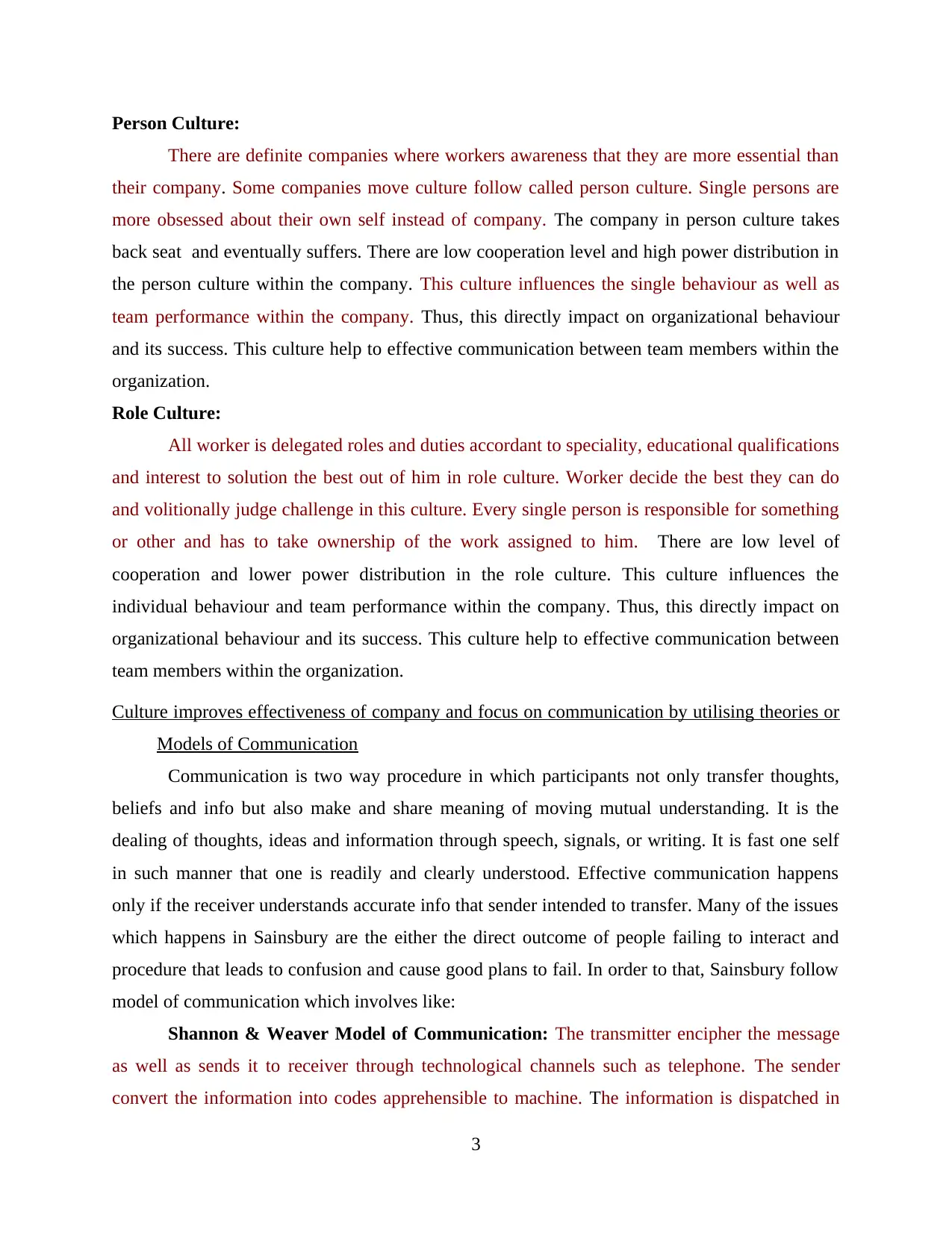
Person Culture:
There are definite companies where workers awareness that they are more essential than
their company. Some companies move culture follow called person culture. Single persons are
more obsessed about their own self instead of company. The company in person culture takes
back seat and eventually suffers. There are low cooperation level and high power distribution in
the person culture within the company. This culture influences the single behaviour as well as
team performance within the company. Thus, this directly impact on organizational behaviour
and its success. This culture help to effective communication between team members within the
organization.
Role Culture:
All worker is delegated roles and duties accordant to speciality, educational qualifications
and interest to solution the best out of him in role culture. Worker decide the best they can do
and volitionally judge challenge in this culture. Every single person is responsible for something
or other and has to take ownership of the work assigned to him. There are low level of
cooperation and lower power distribution in the role culture. This culture influences the
individual behaviour and team performance within the company. Thus, this directly impact on
organizational behaviour and its success. This culture help to effective communication between
team members within the organization.
Culture improves effectiveness of company and focus on communication by utilising theories or
Models of Communication
Communication is two way procedure in which participants not only transfer thoughts,
beliefs and info but also make and share meaning of moving mutual understanding. It is the
dealing of thoughts, ideas and information through speech, signals, or writing. It is fast one self
in such manner that one is readily and clearly understood. Effective communication happens
only if the receiver understands accurate info that sender intended to transfer. Many of the issues
which happens in Sainsbury are the either the direct outcome of people failing to interact and
procedure that leads to confusion and cause good plans to fail. In order to that, Sainsbury follow
model of communication which involves like:
Shannon & Weaver Model of Communication: The transmitter encipher the message
as well as sends it to receiver through technological channels such as telephone. The sender
convert the information into codes apprehensible to machine. The information is dispatched in
3
There are definite companies where workers awareness that they are more essential than
their company. Some companies move culture follow called person culture. Single persons are
more obsessed about their own self instead of company. The company in person culture takes
back seat and eventually suffers. There are low cooperation level and high power distribution in
the person culture within the company. This culture influences the single behaviour as well as
team performance within the company. Thus, this directly impact on organizational behaviour
and its success. This culture help to effective communication between team members within the
organization.
Role Culture:
All worker is delegated roles and duties accordant to speciality, educational qualifications
and interest to solution the best out of him in role culture. Worker decide the best they can do
and volitionally judge challenge in this culture. Every single person is responsible for something
or other and has to take ownership of the work assigned to him. There are low level of
cooperation and lower power distribution in the role culture. This culture influences the
individual behaviour and team performance within the company. Thus, this directly impact on
organizational behaviour and its success. This culture help to effective communication between
team members within the organization.
Culture improves effectiveness of company and focus on communication by utilising theories or
Models of Communication
Communication is two way procedure in which participants not only transfer thoughts,
beliefs and info but also make and share meaning of moving mutual understanding. It is the
dealing of thoughts, ideas and information through speech, signals, or writing. It is fast one self
in such manner that one is readily and clearly understood. Effective communication happens
only if the receiver understands accurate info that sender intended to transfer. Many of the issues
which happens in Sainsbury are the either the direct outcome of people failing to interact and
procedure that leads to confusion and cause good plans to fail. In order to that, Sainsbury follow
model of communication which involves like:
Shannon & Weaver Model of Communication: The transmitter encipher the message
as well as sends it to receiver through technological channels such as telephone. The sender
convert the information into codes apprehensible to machine. The information is dispatched in
3
⊘ This is a preview!⊘
Do you want full access?
Subscribe today to unlock all pages.

Trusted by 1+ million students worldwide
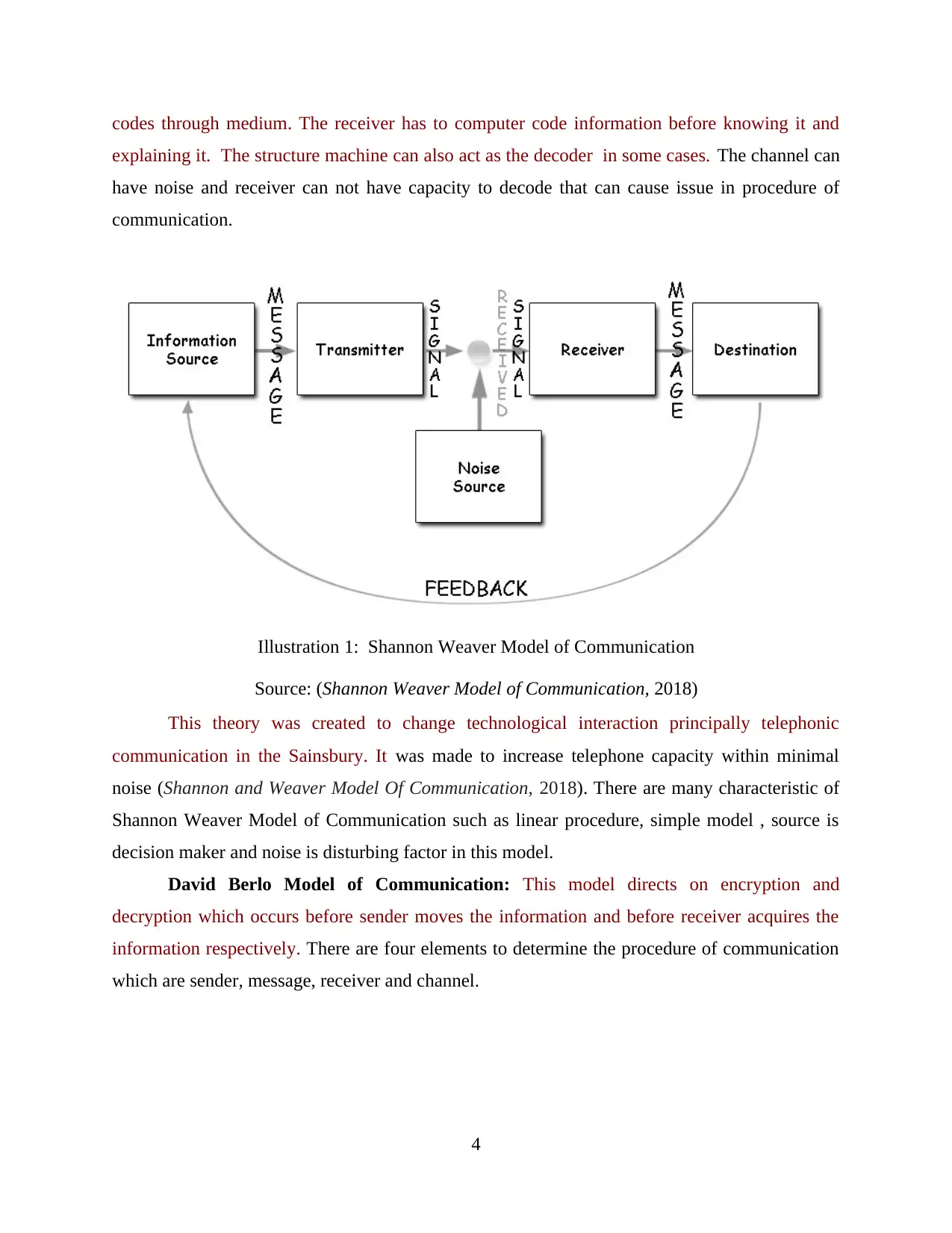
codes through medium. The receiver has to computer code information before knowing it and
explaining it. The structure machine can also act as the decoder in some cases. The channel can
have noise and receiver can not have capacity to decode that can cause issue in procedure of
communication.
This theory was created to change technological interaction principally telephonic
communication in the Sainsbury. It was made to increase telephone capacity within minimal
noise (Shannon and Weaver Model Of Communication, 2018). There are many characteristic of
Shannon Weaver Model of Communication such as linear procedure, simple model , source is
decision maker and noise is disturbing factor in this model.
David Berlo Model of Communication: This model directs on encryption and
decryption which occurs before sender moves the information and before receiver acquires the
information respectively. There are four elements to determine the procedure of communication
which are sender, message, receiver and channel.
4
Illustration 1: Shannon Weaver Model of Communication
Source: (Shannon Weaver Model of Communication, 2018)
explaining it. The structure machine can also act as the decoder in some cases. The channel can
have noise and receiver can not have capacity to decode that can cause issue in procedure of
communication.
This theory was created to change technological interaction principally telephonic
communication in the Sainsbury. It was made to increase telephone capacity within minimal
noise (Shannon and Weaver Model Of Communication, 2018). There are many characteristic of
Shannon Weaver Model of Communication such as linear procedure, simple model , source is
decision maker and noise is disturbing factor in this model.
David Berlo Model of Communication: This model directs on encryption and
decryption which occurs before sender moves the information and before receiver acquires the
information respectively. There are four elements to determine the procedure of communication
which are sender, message, receiver and channel.
4
Illustration 1: Shannon Weaver Model of Communication
Source: (Shannon Weaver Model of Communication, 2018)
Paraphrase This Document
Need a fresh take? Get an instant paraphrase of this document with our AI Paraphraser
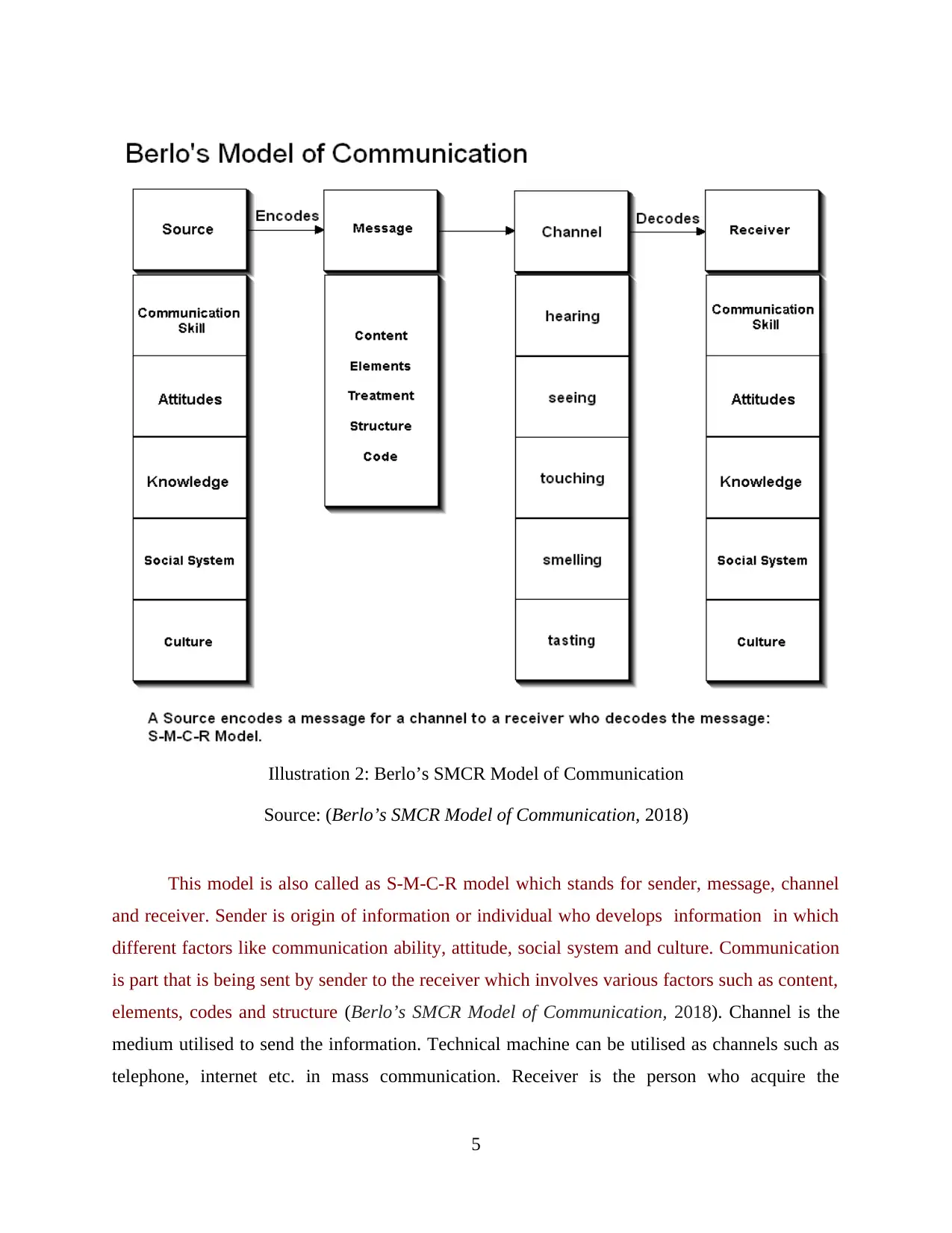
This model is also called as S-M-C-R model which stands for sender, message, channel
and receiver. Sender is origin of information or individual who develops information in which
different factors like communication ability, attitude, social system and culture. Communication
is part that is being sent by sender to the receiver which involves various factors such as content,
elements, codes and structure (Berlo’s SMCR Model of Communication, 2018). Channel is the
medium utilised to send the information. Technical machine can be utilised as channels such as
telephone, internet etc. in mass communication. Receiver is the person who acquire the
5
Illustration 2: Berlo’s SMCR Model of Communication
Source: (Berlo’s SMCR Model of Communication, 2018)
and receiver. Sender is origin of information or individual who develops information in which
different factors like communication ability, attitude, social system and culture. Communication
is part that is being sent by sender to the receiver which involves various factors such as content,
elements, codes and structure (Berlo’s SMCR Model of Communication, 2018). Channel is the
medium utilised to send the information. Technical machine can be utilised as channels such as
telephone, internet etc. in mass communication. Receiver is the person who acquire the
5
Illustration 2: Berlo’s SMCR Model of Communication
Source: (Berlo’s SMCR Model of Communication, 2018)
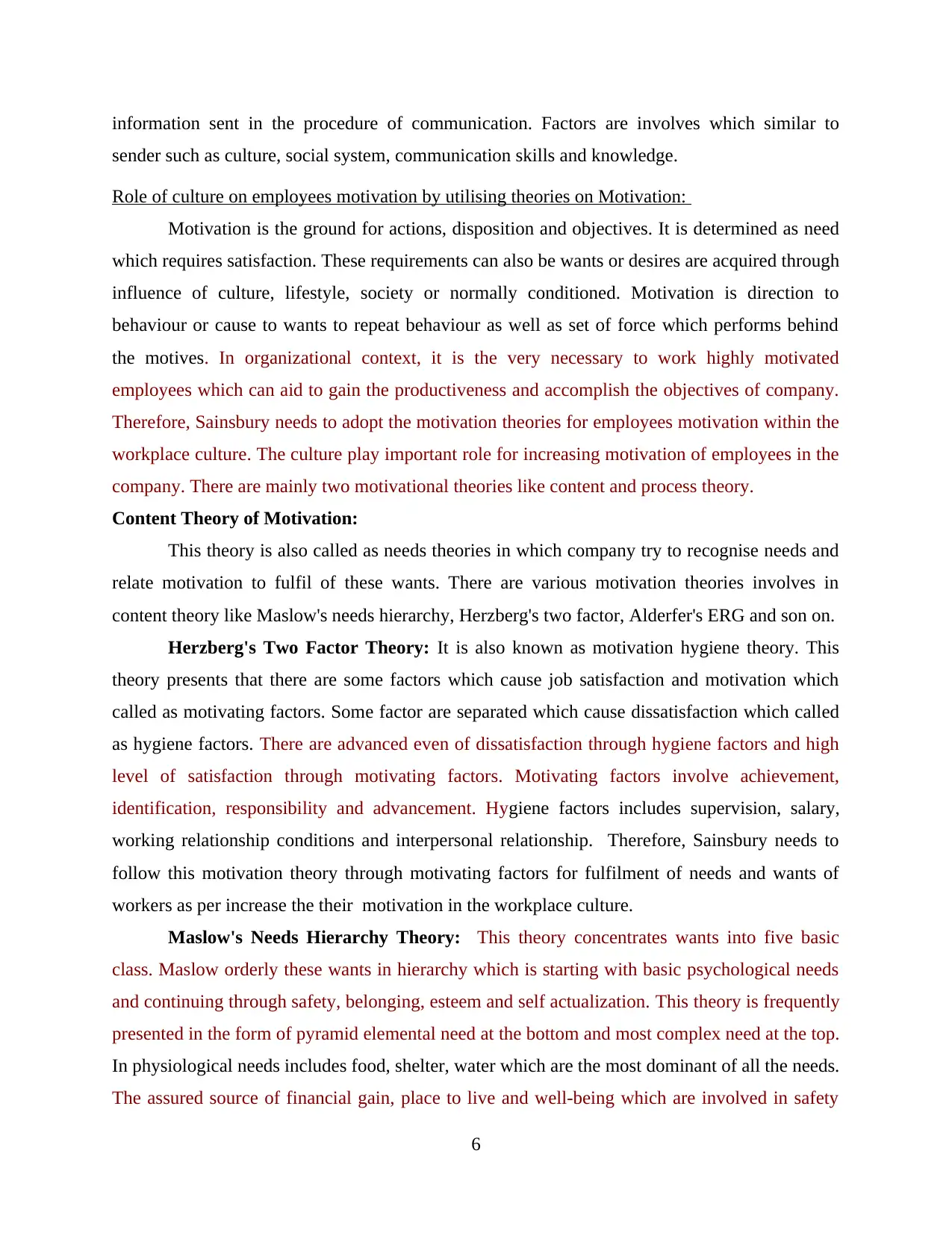
information sent in the procedure of communication. Factors are involves which similar to
sender such as culture, social system, communication skills and knowledge.
Role of culture on employees motivation by utilising theories on Motivation:
Motivation is the ground for actions, disposition and objectives. It is determined as need
which requires satisfaction. These requirements can also be wants or desires are acquired through
influence of culture, lifestyle, society or normally conditioned. Motivation is direction to
behaviour or cause to wants to repeat behaviour as well as set of force which performs behind
the motives. In organizational context, it is the very necessary to work highly motivated
employees which can aid to gain the productiveness and accomplish the objectives of company.
Therefore, Sainsbury needs to adopt the motivation theories for employees motivation within the
workplace culture. The culture play important role for increasing motivation of employees in the
company. There are mainly two motivational theories like content and process theory.
Content Theory of Motivation:
This theory is also called as needs theories in which company try to recognise needs and
relate motivation to fulfil of these wants. There are various motivation theories involves in
content theory like Maslow's needs hierarchy, Herzberg's two factor, Alderfer's ERG and son on.
Herzberg's Two Factor Theory: It is also known as motivation hygiene theory. This
theory presents that there are some factors which cause job satisfaction and motivation which
called as motivating factors. Some factor are separated which cause dissatisfaction which called
as hygiene factors. There are advanced even of dissatisfaction through hygiene factors and high
level of satisfaction through motivating factors. Motivating factors involve achievement,
identification, responsibility and advancement. Hygiene factors includes supervision, salary,
working relationship conditions and interpersonal relationship. Therefore, Sainsbury needs to
follow this motivation theory through motivating factors for fulfilment of needs and wants of
workers as per increase the their motivation in the workplace culture.
Maslow's Needs Hierarchy Theory: This theory concentrates wants into five basic
class. Maslow orderly these wants in hierarchy which is starting with basic psychological needs
and continuing through safety, belonging, esteem and self actualization. This theory is frequently
presented in the form of pyramid elemental need at the bottom and most complex need at the top.
In physiological needs includes food, shelter, water which are the most dominant of all the needs.
The assured source of financial gain, place to live and well-being which are involved in safety
6
sender such as culture, social system, communication skills and knowledge.
Role of culture on employees motivation by utilising theories on Motivation:
Motivation is the ground for actions, disposition and objectives. It is determined as need
which requires satisfaction. These requirements can also be wants or desires are acquired through
influence of culture, lifestyle, society or normally conditioned. Motivation is direction to
behaviour or cause to wants to repeat behaviour as well as set of force which performs behind
the motives. In organizational context, it is the very necessary to work highly motivated
employees which can aid to gain the productiveness and accomplish the objectives of company.
Therefore, Sainsbury needs to adopt the motivation theories for employees motivation within the
workplace culture. The culture play important role for increasing motivation of employees in the
company. There are mainly two motivational theories like content and process theory.
Content Theory of Motivation:
This theory is also called as needs theories in which company try to recognise needs and
relate motivation to fulfil of these wants. There are various motivation theories involves in
content theory like Maslow's needs hierarchy, Herzberg's two factor, Alderfer's ERG and son on.
Herzberg's Two Factor Theory: It is also known as motivation hygiene theory. This
theory presents that there are some factors which cause job satisfaction and motivation which
called as motivating factors. Some factor are separated which cause dissatisfaction which called
as hygiene factors. There are advanced even of dissatisfaction through hygiene factors and high
level of satisfaction through motivating factors. Motivating factors involve achievement,
identification, responsibility and advancement. Hygiene factors includes supervision, salary,
working relationship conditions and interpersonal relationship. Therefore, Sainsbury needs to
follow this motivation theory through motivating factors for fulfilment of needs and wants of
workers as per increase the their motivation in the workplace culture.
Maslow's Needs Hierarchy Theory: This theory concentrates wants into five basic
class. Maslow orderly these wants in hierarchy which is starting with basic psychological needs
and continuing through safety, belonging, esteem and self actualization. This theory is frequently
presented in the form of pyramid elemental need at the bottom and most complex need at the top.
In physiological needs includes food, shelter, water which are the most dominant of all the needs.
The assured source of financial gain, place to live and well-being which are involved in safety
6
⊘ This is a preview!⊘
Do you want full access?
Subscribe today to unlock all pages.

Trusted by 1+ million students worldwide
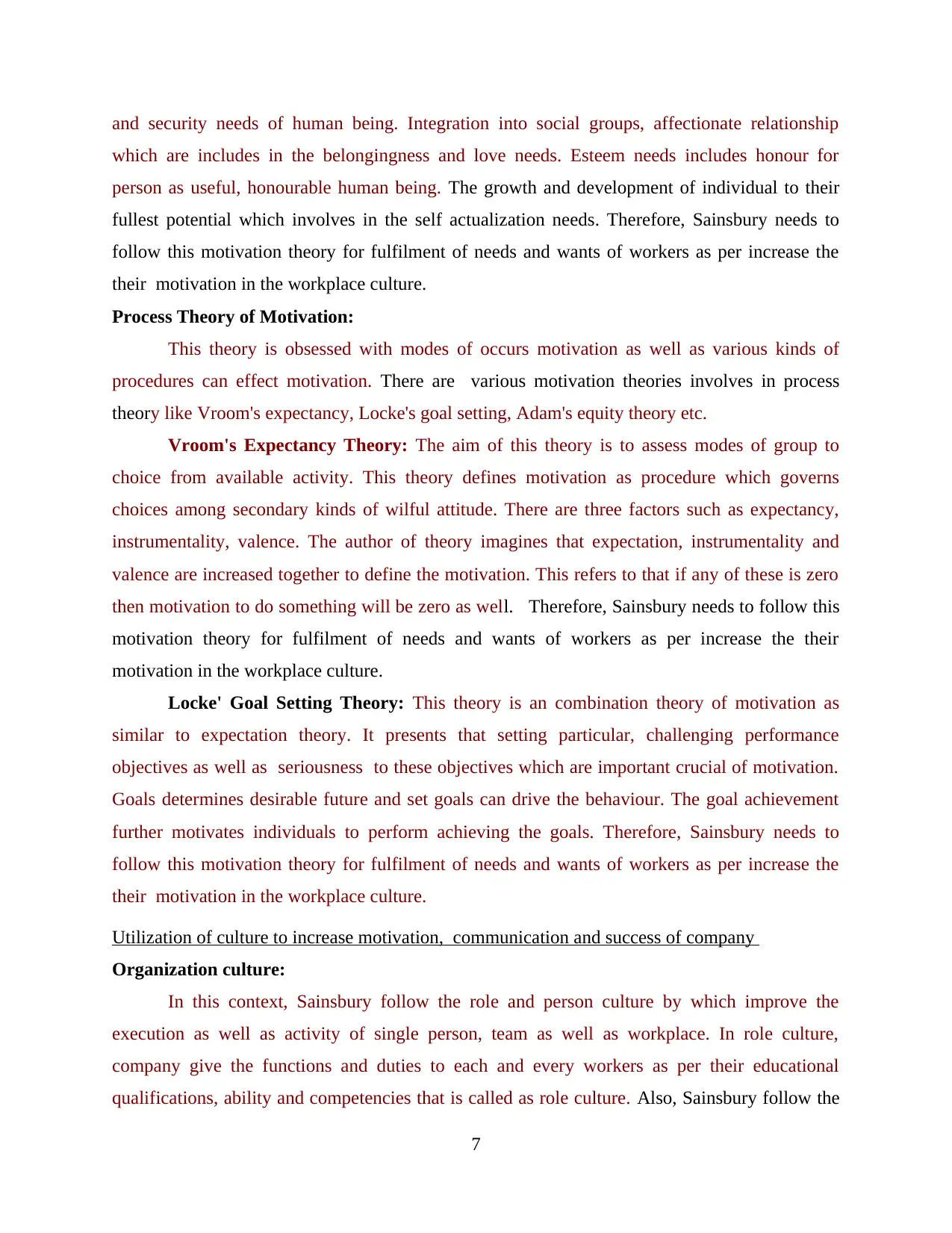
and security needs of human being. Integration into social groups, affectionate relationship
which are includes in the belongingness and love needs. Esteem needs includes honour for
person as useful, honourable human being. The growth and development of individual to their
fullest potential which involves in the self actualization needs. Therefore, Sainsbury needs to
follow this motivation theory for fulfilment of needs and wants of workers as per increase the
their motivation in the workplace culture.
Process Theory of Motivation:
This theory is obsessed with modes of occurs motivation as well as various kinds of
procedures can effect motivation. There are various motivation theories involves in process
theory like Vroom's expectancy, Locke's goal setting, Adam's equity theory etc.
Vroom's Expectancy Theory: The aim of this theory is to assess modes of group to
choice from available activity. This theory defines motivation as procedure which governs
choices among secondary kinds of wilful attitude. There are three factors such as expectancy,
instrumentality, valence. The author of theory imagines that expectation, instrumentality and
valence are increased together to define the motivation. This refers to that if any of these is zero
then motivation to do something will be zero as well. Therefore, Sainsbury needs to follow this
motivation theory for fulfilment of needs and wants of workers as per increase the their
motivation in the workplace culture.
Locke' Goal Setting Theory: This theory is an combination theory of motivation as
similar to expectation theory. It presents that setting particular, challenging performance
objectives as well as seriousness to these objectives which are important crucial of motivation.
Goals determines desirable future and set goals can drive the behaviour. The goal achievement
further motivates individuals to perform achieving the goals. Therefore, Sainsbury needs to
follow this motivation theory for fulfilment of needs and wants of workers as per increase the
their motivation in the workplace culture.
Utilization of culture to increase motivation, communication and success of company
Organization culture:
In this context, Sainsbury follow the role and person culture by which improve the
execution as well as activity of single person, team as well as workplace. In role culture,
company give the functions and duties to each and every workers as per their educational
qualifications, ability and competencies that is called as role culture. Also, Sainsbury follow the
7
which are includes in the belongingness and love needs. Esteem needs includes honour for
person as useful, honourable human being. The growth and development of individual to their
fullest potential which involves in the self actualization needs. Therefore, Sainsbury needs to
follow this motivation theory for fulfilment of needs and wants of workers as per increase the
their motivation in the workplace culture.
Process Theory of Motivation:
This theory is obsessed with modes of occurs motivation as well as various kinds of
procedures can effect motivation. There are various motivation theories involves in process
theory like Vroom's expectancy, Locke's goal setting, Adam's equity theory etc.
Vroom's Expectancy Theory: The aim of this theory is to assess modes of group to
choice from available activity. This theory defines motivation as procedure which governs
choices among secondary kinds of wilful attitude. There are three factors such as expectancy,
instrumentality, valence. The author of theory imagines that expectation, instrumentality and
valence are increased together to define the motivation. This refers to that if any of these is zero
then motivation to do something will be zero as well. Therefore, Sainsbury needs to follow this
motivation theory for fulfilment of needs and wants of workers as per increase the their
motivation in the workplace culture.
Locke' Goal Setting Theory: This theory is an combination theory of motivation as
similar to expectation theory. It presents that setting particular, challenging performance
objectives as well as seriousness to these objectives which are important crucial of motivation.
Goals determines desirable future and set goals can drive the behaviour. The goal achievement
further motivates individuals to perform achieving the goals. Therefore, Sainsbury needs to
follow this motivation theory for fulfilment of needs and wants of workers as per increase the
their motivation in the workplace culture.
Utilization of culture to increase motivation, communication and success of company
Organization culture:
In this context, Sainsbury follow the role and person culture by which improve the
execution as well as activity of single person, team as well as workplace. In role culture,
company give the functions and duties to each and every workers as per their educational
qualifications, ability and competencies that is called as role culture. Also, Sainsbury follow the
7
Paraphrase This Document
Need a fresh take? Get an instant paraphrase of this document with our AI Paraphraser
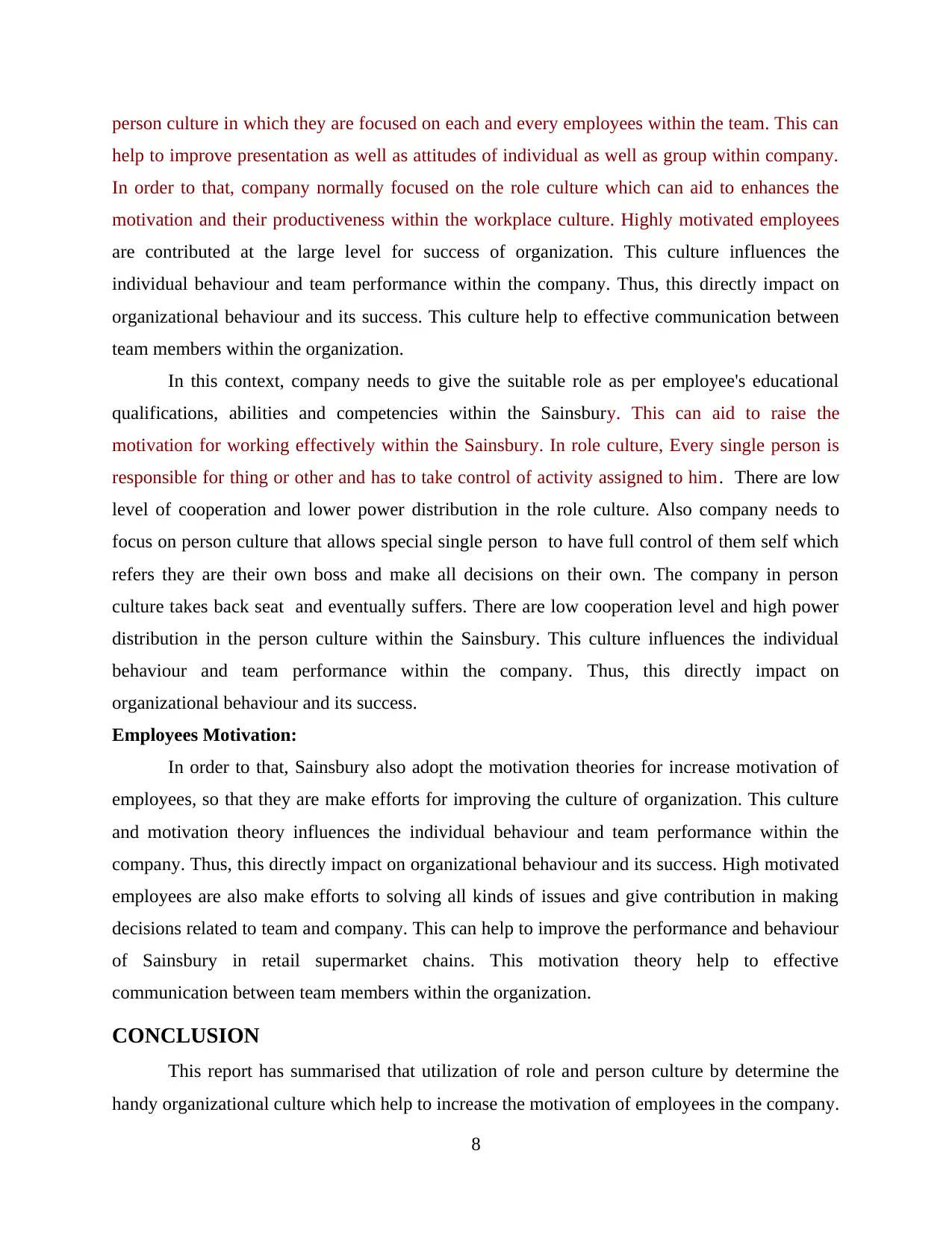
person culture in which they are focused on each and every employees within the team. This can
help to improve presentation as well as attitudes of individual as well as group within company.
In order to that, company normally focused on the role culture which can aid to enhances the
motivation and their productiveness within the workplace culture. Highly motivated employees
are contributed at the large level for success of organization. This culture influences the
individual behaviour and team performance within the company. Thus, this directly impact on
organizational behaviour and its success. This culture help to effective communication between
team members within the organization.
In this context, company needs to give the suitable role as per employee's educational
qualifications, abilities and competencies within the Sainsbury. This can aid to raise the
motivation for working effectively within the Sainsbury. In role culture, Every single person is
responsible for thing or other and has to take control of activity assigned to him. There are low
level of cooperation and lower power distribution in the role culture. Also company needs to
focus on person culture that allows special single person to have full control of them self which
refers they are their own boss and make all decisions on their own. The company in person
culture takes back seat and eventually suffers. There are low cooperation level and high power
distribution in the person culture within the Sainsbury. This culture influences the individual
behaviour and team performance within the company. Thus, this directly impact on
organizational behaviour and its success.
Employees Motivation:
In order to that, Sainsbury also adopt the motivation theories for increase motivation of
employees, so that they are make efforts for improving the culture of organization. This culture
and motivation theory influences the individual behaviour and team performance within the
company. Thus, this directly impact on organizational behaviour and its success. High motivated
employees are also make efforts to solving all kinds of issues and give contribution in making
decisions related to team and company. This can help to improve the performance and behaviour
of Sainsbury in retail supermarket chains. This motivation theory help to effective
communication between team members within the organization.
CONCLUSION
This report has summarised that utilization of role and person culture by determine the
handy organizational culture which help to increase the motivation of employees in the company.
8
help to improve presentation as well as attitudes of individual as well as group within company.
In order to that, company normally focused on the role culture which can aid to enhances the
motivation and their productiveness within the workplace culture. Highly motivated employees
are contributed at the large level for success of organization. This culture influences the
individual behaviour and team performance within the company. Thus, this directly impact on
organizational behaviour and its success. This culture help to effective communication between
team members within the organization.
In this context, company needs to give the suitable role as per employee's educational
qualifications, abilities and competencies within the Sainsbury. This can aid to raise the
motivation for working effectively within the Sainsbury. In role culture, Every single person is
responsible for thing or other and has to take control of activity assigned to him. There are low
level of cooperation and lower power distribution in the role culture. Also company needs to
focus on person culture that allows special single person to have full control of them self which
refers they are their own boss and make all decisions on their own. The company in person
culture takes back seat and eventually suffers. There are low cooperation level and high power
distribution in the person culture within the Sainsbury. This culture influences the individual
behaviour and team performance within the company. Thus, this directly impact on
organizational behaviour and its success.
Employees Motivation:
In order to that, Sainsbury also adopt the motivation theories for increase motivation of
employees, so that they are make efforts for improving the culture of organization. This culture
and motivation theory influences the individual behaviour and team performance within the
company. Thus, this directly impact on organizational behaviour and its success. High motivated
employees are also make efforts to solving all kinds of issues and give contribution in making
decisions related to team and company. This can help to improve the performance and behaviour
of Sainsbury in retail supermarket chains. This motivation theory help to effective
communication between team members within the organization.
CONCLUSION
This report has summarised that utilization of role and person culture by determine the
handy organizational culture which help to increase the motivation of employees in the company.
8
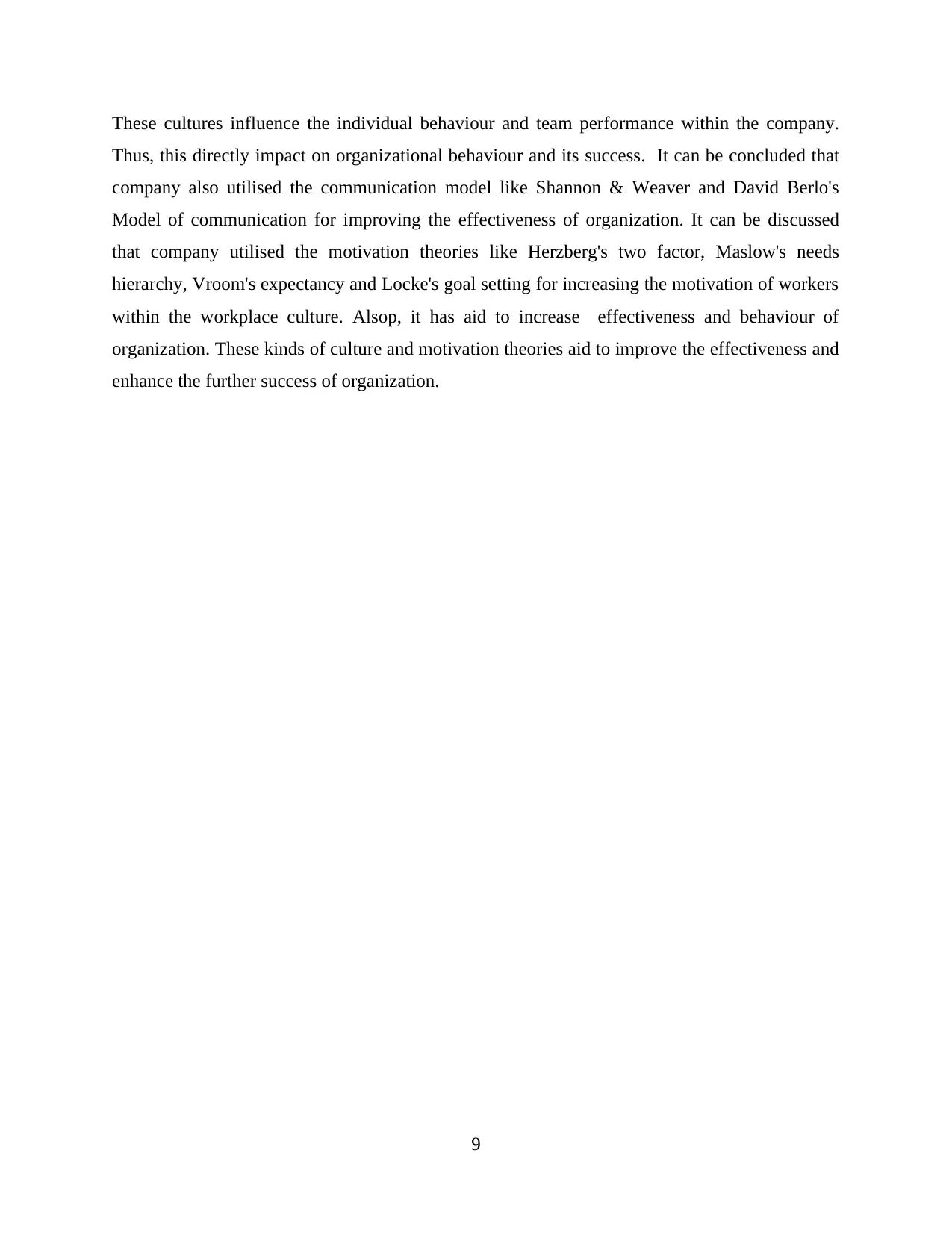
These cultures influence the individual behaviour and team performance within the company.
Thus, this directly impact on organizational behaviour and its success. It can be concluded that
company also utilised the communication model like Shannon & Weaver and David Berlo's
Model of communication for improving the effectiveness of organization. It can be discussed
that company utilised the motivation theories like Herzberg's two factor, Maslow's needs
hierarchy, Vroom's expectancy and Locke's goal setting for increasing the motivation of workers
within the workplace culture. Alsop, it has aid to increase effectiveness and behaviour of
organization. These kinds of culture and motivation theories aid to improve the effectiveness and
enhance the further success of organization.
9
Thus, this directly impact on organizational behaviour and its success. It can be concluded that
company also utilised the communication model like Shannon & Weaver and David Berlo's
Model of communication for improving the effectiveness of organization. It can be discussed
that company utilised the motivation theories like Herzberg's two factor, Maslow's needs
hierarchy, Vroom's expectancy and Locke's goal setting for increasing the motivation of workers
within the workplace culture. Alsop, it has aid to increase effectiveness and behaviour of
organization. These kinds of culture and motivation theories aid to improve the effectiveness and
enhance the further success of organization.
9
⊘ This is a preview!⊘
Do you want full access?
Subscribe today to unlock all pages.

Trusted by 1+ million students worldwide
1 out of 14
Related Documents
Your All-in-One AI-Powered Toolkit for Academic Success.
+13062052269
info@desklib.com
Available 24*7 on WhatsApp / Email
![[object Object]](/_next/static/media/star-bottom.7253800d.svg)
Unlock your academic potential
Copyright © 2020–2025 A2Z Services. All Rights Reserved. Developed and managed by ZUCOL.





